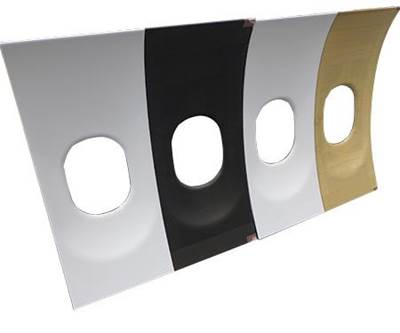Recyclable composites must still be reused
Fresh from the IACMI's recent Detroit conclave, CW editor-in-chief Jeff Sloan notes the attendees' admirable commitment to ensure that the carbon fiber composites we build today will be recyclable tomorrow, but asks who will be there, as those products reach end of life, to buy and reuse those reclaimed materials?
The Institute for Advanced Composites Manufacturing Innovation (IACMI, Knoxville, TN, US), the public/private consortium created to accelerate the evolution of composites technologies in automotive, wind, pressure vessels, design engineering and manufacturing processes, is six months old and in January hosted its second membership meeting in Detroit, MI, US, to coincide with the North American International Auto Show (NAIAS).
The meeting — a “where are we now” update on the consortium’s progress — gathered 290 members, representing every stratum of the composites industry, including suppliers, OEMs, academicians and government officials.
In terms of size (US$259 million in public and private funds), scope and ambition, IACMI is a first-of-its-kind organization for the American composites industry, and it has set some decidedly ambitious goals, ranging from dramatically reducing the cost of carbon fiber manufacture to development of automated, high-speed manufacturing processes for wind energy and automotive applications.
It is, thus, understandable that some members — despite already having invested in the consortium — exhibited skepticism about its viability. Indeed, during breaks at the Detroit meeting, it was not uncommon to be asked, “So, what do you think? Does this thing have a chance?”
If the first six months of progress represent what is to come, I, for one, am optimistic. There are, at IACMI’s helm, people passionate and knowledgeable about composites manufacturing, and clearly dedicated to seeing the consortium sustain itself beyond the initial five-year funding window. Already, IACMI is investing in substantial development work that proves this is not a government-sponsored boondoggle (for a full report on the meeting, visit short.compositesworld.com/IACMI16).
Most of IACMI’s goals, although ambitious, strike me as realistic and, if achieved, could move the composites industry forward substantially in terms of efficiency, manufacturing quality and cost. There is one goal, however, that, to be met, will require not just money and effort and creativity, but the creation of an entirely new end-market. By 2020, 80% of all glass and carbon fiber composite parts must be recyclable, and by 2025, >95% of those parts must be recyclable.
We have the technology, today, to recycle cured and uncured composite materials of many types. In this sense, nearly every composite part is already “recyclable,” and could be recycled with an investment in the capital and equipment required for the task. But it’s one thing to assume that the part eventually will be recyclable, but quite another to presume that it, in fact, will be recycled and reused in one of a host of applications designed to consume used or non-virgin fiber. And that’s the rub. There is, today, no “host of applications” waiting for the wave of recycled fiber that will, if IACMI succeeds, flood the market.
Creating that host of applications will be no trivial undertaking. Recycled fiber must first be tested and characterized. Is it glass or carbon? Is it chopped? If so, how long are the fibers? What are the strength and stiffness properties? These properties then must be matched up with potential applications. Further, given the volume of used material that conceivably could be made available, it will probably be necessary for some large OEMs — Boeing, Airbus, Ford, Toyota, etc. — to step up and commit to an effort to find a use for recycled fibers, like BMW has done with its i3 roof.
One step in the right direction can be found this month in "Recycled carbon fiber proves its potential for aircraft interiors," a story written by senior editor Ginger Gardiner about use of recycled carbon fiber by Airbus in an aircraft interiors R&D program (read more by clicking on its title under "Editor's Picks" at top right). A successful recycling industry, however, will require thousands of efforts like this one. And soon.
The bottom line is this: The composites industry’s expansion is creating a waste stream for which we all must take responsibility. I hope that IACMI’s edict will provide the spark we need.
Related Content
Forvia brand Faurecia exhibits XL CGH2 tank, cryogenic LH2 storage solution for heavy-duty trucks
Part of its full hydrogen solutions portfolio at IAA Transportation 2022, Faurecia also highlighted sustainable thermoplastic tanks and smart tanks for better safety via structural integrity monitoring.
Read MoreJEC World 2022, Part 3: Emphasizing emerging markets, thermoplastics and carbon fiber
CW editor-in-chief Jeff Sloan identifies companies exhibiting at JEC World 2022 that are advancing both materials and technologies for the growing AAM, hydrogen, automotive and sustainability markets.
Read MorePlant tour: ÉireComposites, Galway, Ireland
An in-house testing business and R&D focus has led to innovative materials use and projects in a range of markets, from civil aerospace to renewable energy to marine.
Read MoreInfinite Composites: Type V tanks for space, hydrogen, automotive and more
After a decade of proving its linerless, weight-saving composite tanks with NASA and more than 30 aerospace companies, this CryoSphere pioneer is scaling for growth in commercial space and sustainable transportation on Earth.
Read MoreRead Next
Recycled carbon fiber proves its potential for aircraft interiors
An Airbus-led team characterizes RCF veils and shows their ability to best glass fiber composite sidewalls in cost, weight and surface finish.
Read MoreFrom the CW Archives: The tale of the thermoplastic cryotank
In 2006, guest columnist Bob Hartunian related the story of his efforts two decades prior, while at McDonnell Douglas, to develop a thermoplastic composite crytank for hydrogen storage. He learned a lot of lessons.
Read MoreComposites end markets: Energy (2024)
Composites are used widely in oil/gas, wind and other renewable energy applications. Despite market challenges, growth potential and innovation for composites continue.
Read More

















.jpg;maxWidth=300;quality=90)







